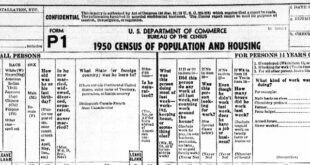After around 30 years of research experience, I have reached a point where I do what I do like a machine. I don’t think about the method. I just do it and it works.
In the process of getting ready for presentations on “Beginning Italian Genealogy” I had to ask myself “How did I learn to do this in the first place.’
Then I decided that I don’t want any of you to learn the way I did, which was pure painful trial and error. There should be a simple guideline for the research method, to help you focus on what to do, so you can drill-down each step and say “Ok, how do I do this part?”
So today, let’s go through the research method, which should apply equally to any ancestor, Italian or not.
The key to this method is to focus on one person, and one fact, at a time. If you start finding all the Smiths and Russos in Chicago when you only need one, you’re going to waste a lot of time and not find much for your ancestral tree.
STEP 1: Figure out which pieces of information you want to find.
This is simple to do when you have an ancestral family tree printed, or on the screen, in front of you. The most basic tree shows seven items for each person:
- The person’s full name at birth
- City of birth (and subsequently, the province/county, the state/region, and the country
- Date of birth
- City of marriage (maybe more than one, or zero)
- Date of marriage
- City of death (maybe they’re still with us)
- Date of death
There are other pieces of information, such as military service, occupation etc but the most basic tree chart shows these seven items.
You can look at yourself at the beginning of the tree and you will typically know what to enter for all seven items. Full name, birthdate, birthplace. If you are or have been married, marriage date and city. You can leave death blank for now since you’re still here!
Now you look at your father or mother and see if you have all seven items for them. If you have every one of the Big Seven, start with your four grandparents. At some point, you will find one of the Big Seven is missing for your maternal grandfather, and today, your objective is to find that.
STEP 2: Use information you already have, or look for other records, to determine the town and year for the information you need.
If you know the information, but you haven’t found the actual document, then you need to find the correct document to back up the information, such as a birth certificate, marriage license, or death certificate. Maybe you don’t have those yet, so you can use other documents such as a passenger list, military draft card, naturalization petition or census record to get you closer.
STEP 3: Find the town in the FamilySearch catalog
This is done by using www.familysearch.org, clicking Search, then clicking Catalog. Type the name of the town. Some of the entries in the catalog will hopefully say “Civil registration”. Click on it.
STEP 4: Find which film or folder contains the record you want to find.
Look at the films or folders in the catalog entry. They all have titles that explain what images are in that film/folder. The title should tell you if they are births, marriages or deaths or something else. It should also tell you the year, or a range of years, that appear in that film or folder. So it could say “Atti di Nati, 1907” or it could say “Atti di Nati 1867-1892”. If your record is an 1896 birth, you need to keep looking in the catalog until you see one that includes 1896.
STEP 5: Look at the images in the film/folder until you find the town, record type and year you are looking for
This is the most complicated part of researching.
You need to know that sometimes, one film/folder may contain records for more than one town, more than one type of record, and more than one year. These records were microfilmed in Italy and were combined onto one microfilm roll to save storage space. So when they got done filming the births for the town of Toritto 1900, they then started the births for Triggiano 1866 and went forward from there. So one film may have both towns on it. Sometimes, they would put the 1904 birth records for 18 different towns all on the same film. So when you go to the first image on a film, you might not be looking at the town or year that you want to.
Even if your film/folder only has one town and one type of record, it has multiple years. So no matter what you’re looking for, the records you need are somewhere at a random location within the 3000 or so images on that film/folder.
Every time you look for a record, you have to figure out where your record is on that film full of 3000 images, give or take. Each time you look for a different record, the arrow above will point to a different, unknown place.
I basically use a method called “Divide and Conquer”.
I will start with the first image that contains either a title page or an actual record. I read the image and determine the town, record type and year. Then I jump to the last image and do the same thing. This helps me guess how close the records are that I need.
I will then go to a different image number, usually halfway between 1 and 3000 or whatever total number of images are on this film/folder. I will read the record to decide which direction I need to go in order to find the ones I need.
Then I go halfway forward or back and look again. Then halfway forward or back again. So I would be 1500, then 2250, then 1800, then 2000, then 1900 then 1850. By now I should be close. When I read a record that is the right town, record type and year, I’m almost there.
STEP 6: Find the record by browsing sequentially.
So I am in the right batch of records on this film. I can do one of two methods here.
If I think I know the exact date of the birth/death/marriage, I can just go image by image and watch the dates at the top of each record. I landed on August and I need May, so I go backwards.
OR, I can decide to find the index and look for my ancestor’s name. The index can be either at the beginning or end of the year I am looking at. I can skip 5 or 10 image numbers until I stop seeing records and start seeing lists of names. You go to the letter their surname begins with, and they have the names sequentially (sometimes they are in alpha order but not always). So you see your grandmother’s name, and the number 73 next to it. No parents. No date. Now you have to browse the images until you find #73.
STEP 7: Get information from the record.
Ok. You found Nonna’s birth record. By now you noticed there is more than one record on each image. Births usually have three births per image. Deaths have 4. Marriages have two. You can use this to jump to the right image to save time. (Example, you have 290 births in 1896 in this town. You need #73. There are three per page. Divide 290 by 3 to know how many images there are and you can use the Divide and Conquer to get closer without having to click the arrow 70 times to the left to get to #73. This will all come from experience. I do these calculations in my head, but I’ve been at this for 30 years.
So now that you found it, are you sure it’s yours? There might be another person with that name born that same year. If you already have a birth date from another document, and you found the exact match, you’re there. If you know who her parents were, and the ones on the document match, you’ve found it!
So you should try to get a copy of the document if you can. FamilySearch may not permit you to click “Save” due to the contract restrictions. And I would never suggest you should take a photo with your cell phone……
You should also write down the film/folder number you are using, and the image number you ultimately found. This is very important because if you need to see the image again, you can just get to the film/folder and type the image number, and you’re there!
A class in reading records would take another column, but you need to find the exact date of the event, in case your records are not 100% accurate. Remember that the top of each record shows the date they went to the Mayor’s office, and in the middle of the record you see the date of the birth or death.
You should obviously find the parents. They are on every record.
If you are looking at a birth record, you might find the age of the father, occasionally of the mother. If you are looking at a marriage, you will see the ages of the bride and groom, and the birth towns of both. You’ll also see the parent’s names and whether each of the four parents is living at the time of the marriage of their child, or deceased. This will help you later to find the death date when you have no idea. If you’re looking at a death record, you will see the final spouse’s name and whether they were living or deceased at the time of this death record. You’ll also see the names of the parents and whether they are living or not.
Death dates are the hardest thing to find if you don’t know them at all. You need every record that mentions the same person to know whether they were alive or not at a moment in time. For example:
Palmo Abbinante born 1825 Carbonara Bari Italy
When did he die? At the moment he could have died any time from 1825 until 1925 or maybe beyond.
He got married in 1848, so now we know he was alive 1848 and we rule out 1825 through 1848.
His children were born between 1849 and 1867. The birth of the 867 child says he was alive, so now we know he died between 1867 and 1925. Still a large range of years.
Palmo’s son married in 1877 and Palmo was alive.
Palmo’s daughter married in 1884 and Palmo was alive.
Palmo’s other son was married in 1891 and Palmo was deceased by then. Aha. So he died between 1884 and 1891. Now you only have to search 7 years of deaths instead of 100.
So you now have new information to add to your family tree. Now you can decide the next record to look for and start this process again.
Try this method and send me an e-mail at italianroots@comcast.net and let me know how it went.
Enjoy!
 Fra Noi Embrace Your Inner Italian
Fra Noi Embrace Your Inner Italian






